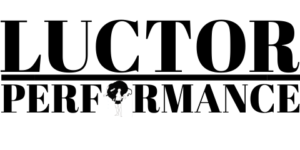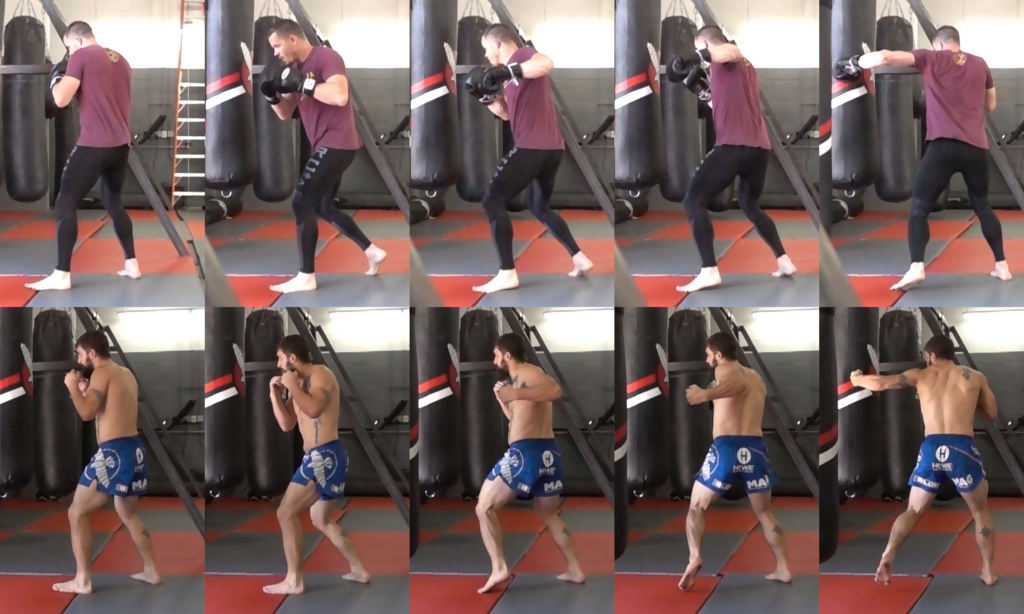
If you have been boxing for a while at some point you have probably had shoulder pain that has limited your training. I imagine that you would like to avoid the pain and keep training. As a Physical Therapist who likes to punch things occasionally, I am going to review a few trouble shooting ideas to see if you can find the potential cause of your pain and then give you some ideas on how to fix it.
Causes of Shoulder Pain
There are 2 ways to look at causes of your shoulder pain. I am going to address both in this article.
1) What is actually hurt? (The anatomical problem area or injured tissue.)
2) Why you got hurt? (What is the root cause of the injury.)
Common Shoulder Injuries in Boxing
***The usual disclaimer: if you are in pain or feel like you have an injury you should seek appropriate medical consultation.
Having someone with appropriate medical training on your team can be extremely helpful in guiding you through the process if you think you possibly have an injury.
What is Actually Hurting?
The first thing you need to do is find out if the pain is actually coming from the shoulder. I know the pain may be in your shoulder but sometimes the pain is actually coming from the neck and radiating towards the shoulder.
One quick screen you can do to see if the neck may be contributing to your symptoms is:
- Look to the right and left as far as you can
- Look up and down as far as you can
- Tilt head side to side as far as you can
If any of your symptoms get better or worse with any of those motions it might be a sign that the symptoms are at least partially coming from your neck.
Also, if any of your symptoms radiate past the elbow towards the hand or into your fingers or you are having weakness in your hand it may also be another indication that your symptoms might be coming from your neck.
*** If you are having any of the symptoms listed above it would be beneficial to go see a qualified medical provider to get assessed
If you have confidently ruled out that the symptoms are not coming from your neck we can now look towards the shoulder…
Rotator Cuff Injuries
The most frequent shoulder injury in boxing is to the rotator cuff. The rotator cuff is a group of small muscles surrounding the shoulder. The main roles of the rotator cuff are:
- Hold the humeral head into the shoulder socket (glenoid). The shoulder joint is kind of like a golf ball on a tee; and, the rotator cuff helps to keep everything in place.
- Move the shoulder move into external, internal, and abduction ranges of motion.
Common injuries to the rotator cuff include strains or tears. You can have acute traumatic injuries that present with immediate sharp pain and weakness ( and inability?) in the ability to raise and move the shoulder in certain directions. You can also have injuries that develop over time due to cumulative stress to the shoulder and not allowing it to heal properly which tend to slowly worsen over time.
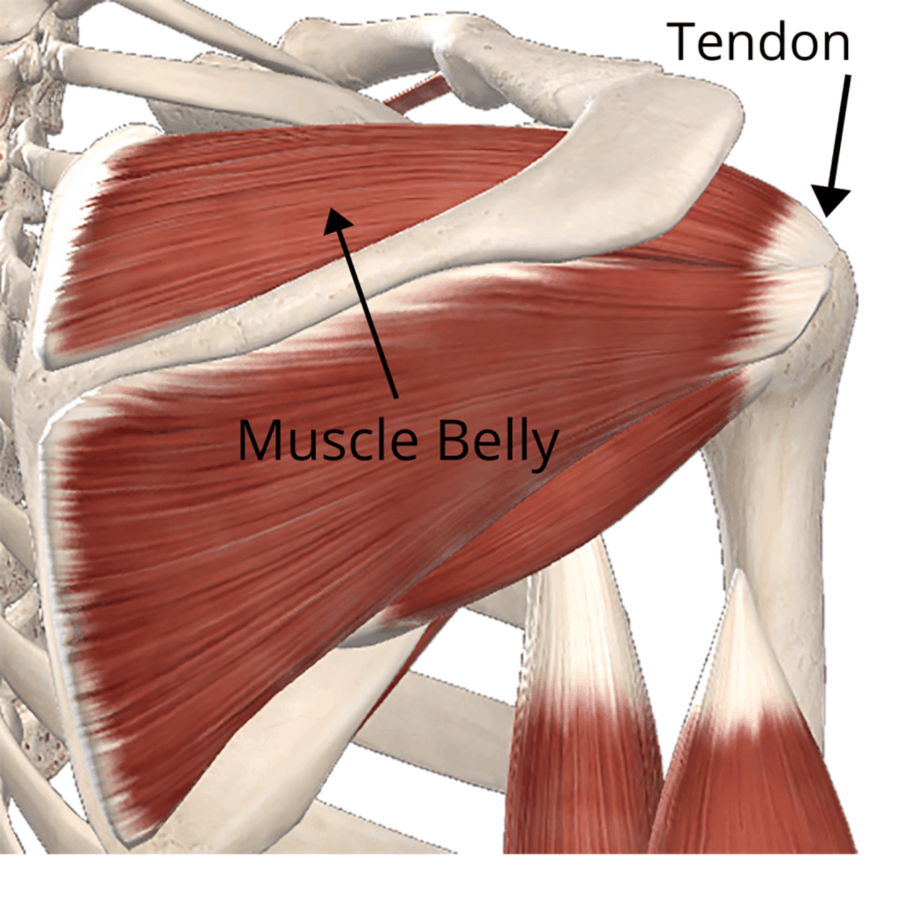
Knowing the the history of the injury or how it took place can give some insight into what it going on in the shoulder. Also, knowing the location of the injury can give some (omit) insight into how long it might take to heal. Muscle injuries tend to heal faster than tendon injuries.
Labral Injuries
One of the next most common shoulder injuries in boxing is to the labrum. The labrum is a ring of cartilage around the glenoid that helps to keep the humeral head in the glenoid. If we go back to the golf ball on tee analogy it is a rim that makes the tee deeper so the ball is less likely to fall out. If there is a tear or injury to the labrum it can lead to instability of the shoulder which can contribute to pain and limitations in shoulder movement.
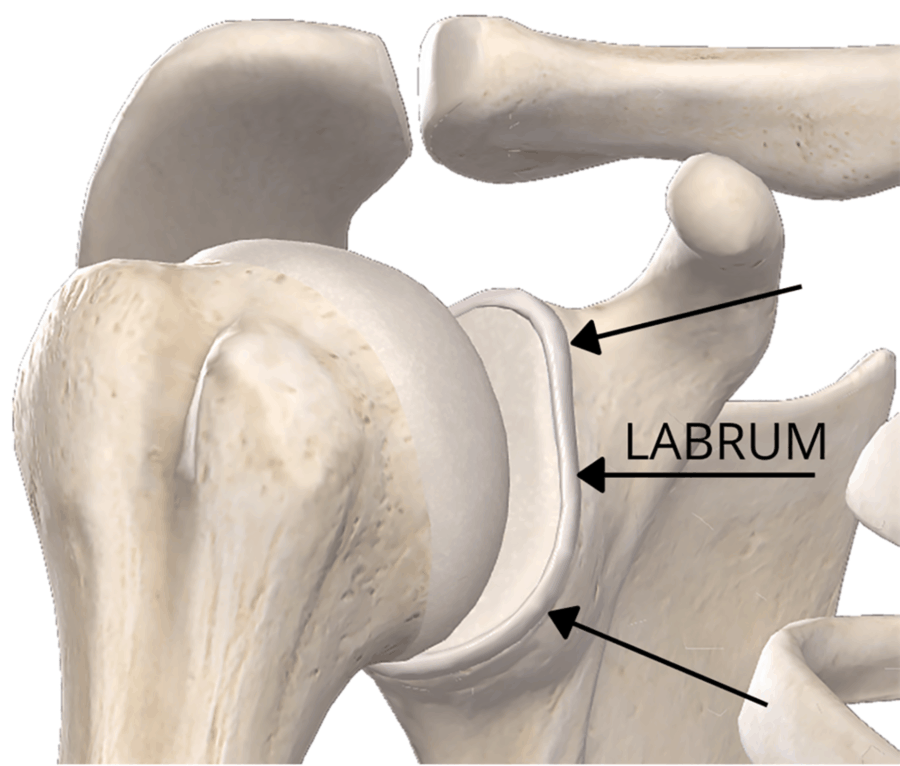
Depending on the severity of the injury it could require surgery to repair the injured area but in many cases it may be possible to rehab the injured tissue.
So now we know the most probable culprits. What can you do about it? To have the best chance of fixing this problem long term you have to know…
Why You Got Hurt in the First Place?
Orthopedic surgeons along with imaging are great at telling you what is wrong or injured. However, in my opinion they are not so good at telling you why it happened in the first place. Knowing why it happened in the first place is important in getting to the root problem. This will hopefully help the injury from reoccurring.
Boxing is a full contact sport. As with all full contact sports there will always be traumatic injuries. However, many injuries in the sport are not traumatic, and can be avoided. Non-contact injuries are areas where we can significantly reduce the likelihood of injuries with smart training.
5 Pillars of Injury Prevention
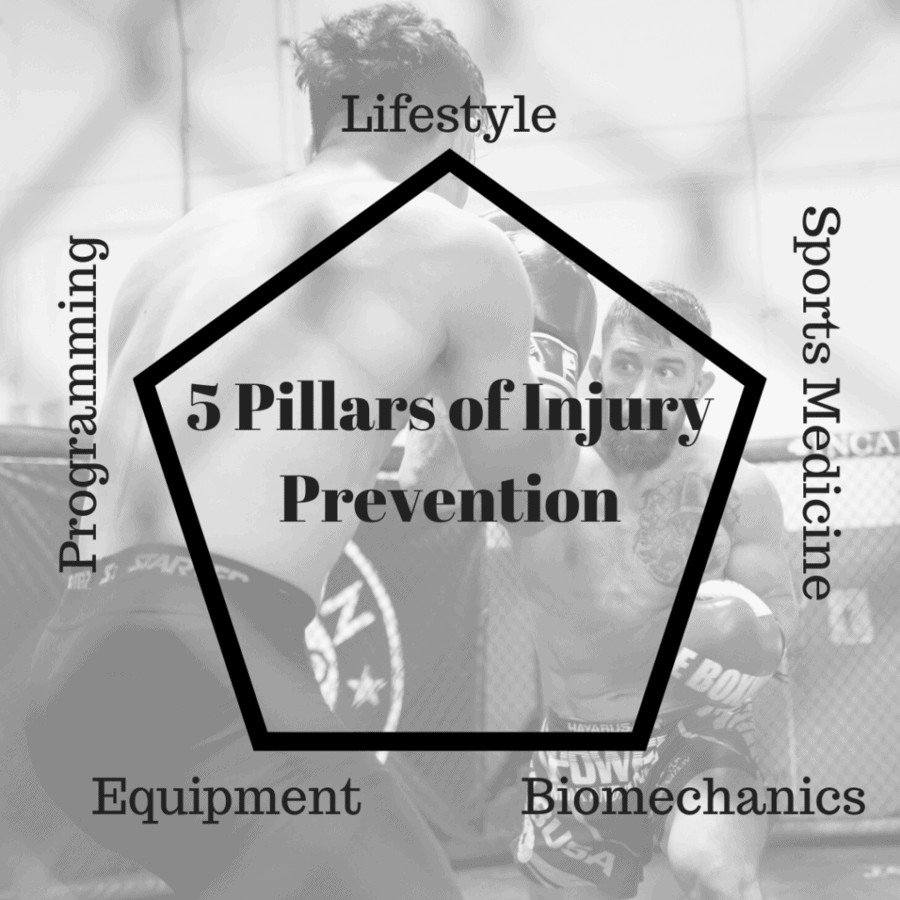
Programming (Load Management)
There are 3 main parameters impacting load management
- Intensity is related to the % of your maximal effort.
- Volume is the amount of work you are doing in a training session, week, or training cycle.
- Density is the amount of work done divided by time.
***A general rule of thumb is that if you are increasing one of these parameters than the other 2 must come down
If you are dealing with an injury it may be beneficial to reduce all 3 parameters to see if things get better and slowly build back up.
With mechanical injuries there are certain motions that are provocative and may be limiting overall range of motion.
- One of our first goals should be to be pain-free at rest.
- Then we should be able to restore pain free range of motion in all ranges of motion (IE. you shoulder be able to reach overhead and behind to scratch your back without pain.)
- Then we need to strengthen the muscles around the shoulder (there are 17 muscles that attach to the scapula alone) and build some resilience in the injured tissue. The body needs load to properly heal and remodel the injured tissue.
- Then we need to be able to integrate this strength/endurance back into boxing training without pain.
This is where having a knowledgeable therapist, strength and conditioning coach and/or sport specific coach in your corner can be helpful in helping determine what is too much or not enough load/training.
When looking at load management you need to look not only what you need to add but what you need to take away. I have found as fighters move through their career often it is not what needs to be added but what needs to be removed that pays the biggest dividends.
Equipment
One problem and, probably the easiest to change, that might be contributing to your pain is your equipment.
Below you will find common types of equipment considerations that may be contributing to your shoulder pain and how to fix these issues:
Heavy bag:
Sometimes using too heavy of a heavy bag will not allow the bag to move with your punch. Also, a bag that is too densely packed may have a similar outcome and will not dissipate the forces of your punch very well. You see these traits commonly in Thai bags designed for kicking which serve their purpose well for kicking but may not always be the best option for punching.
- Your bag is too heavy
- If you use a bag that is too heavy when you strike the bag, instead of your force moving the bag forward, the force is placed on your shoulder.
- Your bag is too densely packed
- If your bag is too densely packed it will have similar outcomes to the bag being too heavy, but the bag will not dissipate your force well, and again will put pressure back on your shoulder
Often times I will see this with athletes working on their boxing with Thai bags which are specifically designed for kicking, and not for punching. Having a dense and heavy bag, works perfect for kicking but can reek havoc on your shoulder.
One solution that has been gaining popularity is using an aqua or water bag as your main heavy bag. The water dissipates some of that compressive force when hitting it. You can buy a generic version on amazon and hang it in your garage for under $100.
Mitts: There are pretty much 2 options for punching mitts. 1) Traditional punch mitts where your hands are in the mitts and 2) Paddles. With traditional punch mitts sometimes the trainer can give too much resistance. I think we have all seen the instance where the pad holder is doing more work than the fighter. In contrast the paddles allow you to punch through the target with less impact to you and your shoulder. The problem with the paddles is sometimes if you miss or are expecting more resistance you can overshoot sometimes which can place your shoulder in vulnerable positions.
Biomechanics and Technique
Biomechanics simply put is the study of human movement and how forces act on the human body. If you have a basic understanding of biomechanics and an understanding of the sport it allows you to recognize efficient and inefficient movement patterns. Improving biomechanical efficiency can potentially be a piece in reducing injuries due to optimizing the way forces move through the body.
Having a team of people to help assess you on that front is helpful. Having a knowledgeable coach that can look at technical errors that may be contributing to your problem is extremely valuable. Also, having a skilled therapist that can look into restriction or limitations that may not allow you to move optimally can be extremely valuable.
One tool we use to analyze technique and give insight into bio-mechanics is a kinogram. I first saw kinograms while in Physical Therapy school. Kinograms are essentially a snapshot at different points in a movement. Kinograms are helpful in my opinion because they can provide a snapshot and eliminate some of the noise found in other methods of observation. They are helpful for inter and intra athlete comparisons. They allow you to quickly compare multiple athletes and see trends between elite and sub elite performers. They can also be helpful to track progress over time.
If you want to try and create your own kinograms for study it is helpful to have a high speed camera. Then you need to determine reference points (ground contacts, contact with bag etc.) to maintain consistency and then compile the images as so.
Kinograms do have their limitations because they are just snapshots and do not necessarily tell the whole picture. However, they improve in value the more frequently do them so you can have multiple data points.
While reviewing the kinograms if you find some movement errors (especially if they may be contributing to your shoulder pain) the next step is to determine what the cause is. It could just be a technical or conceptual error on the part of the fighter that can be changed quickly with some education or cuing. However, it could also be a physiological or structural issue leading to limitations in the athletes movement variability which might be better addressed by the therapist.
Solution: It can be hard to break down the subtleties of some of these movements so it can be very beneficial to enlist the watchful eye of a coach or therapist that may be able to give additional insight into why the fighter is choosing certain movement strategies.
Lifestyle
The lifestyle category can be very broad and almost impossible to address completely in a simple blog post, however, 3 main lifestyle components to consider that can impact your injury risk and how quick you can heal following an injury are:
- Sleep– The recommendation for sleep is 7-9 hours.
- Sleep deprivation reduces endurance, impairs sprint performance, accuracy, reaction time, accuracy, and impairs learning
- Lack of sleep significantly increases injury risk (up to 75% in some populations), and increases risk of getting sick
- Nutrition–
- Hydration is one of many aspects of nutrition that impact fighters especially. A 2.5% reduction in body weight due to water loss can result in 45% reduction in performance. General rule of thumb is for every pound of sweat lost you should replace with 2-3 cups of water post training.
- Stress
- There is evidence that times of high stress (even academic stress) increases injury risk. Link to Study
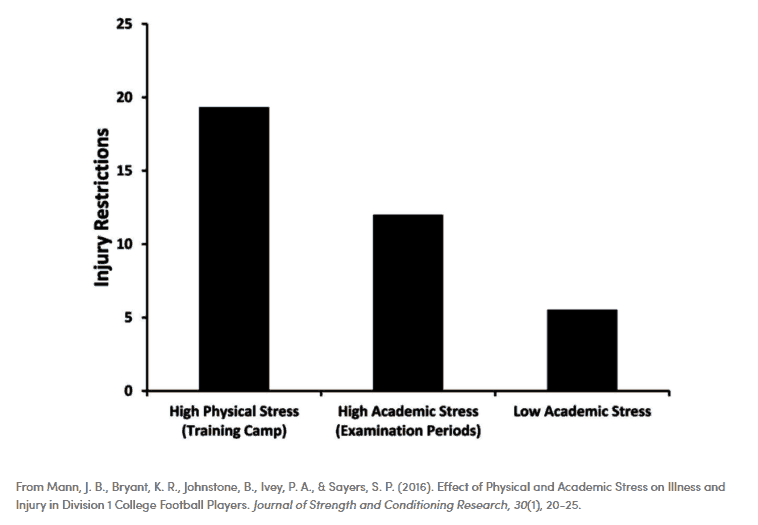
Usually in the lifestyle category it is stuff we know we should be doing but just need to do a better job of actually doing it.
Sports Medicine/Therapy
The goal of Sports Medicine is to assess, diagnose, manage, mitigate, and prevent injuries.
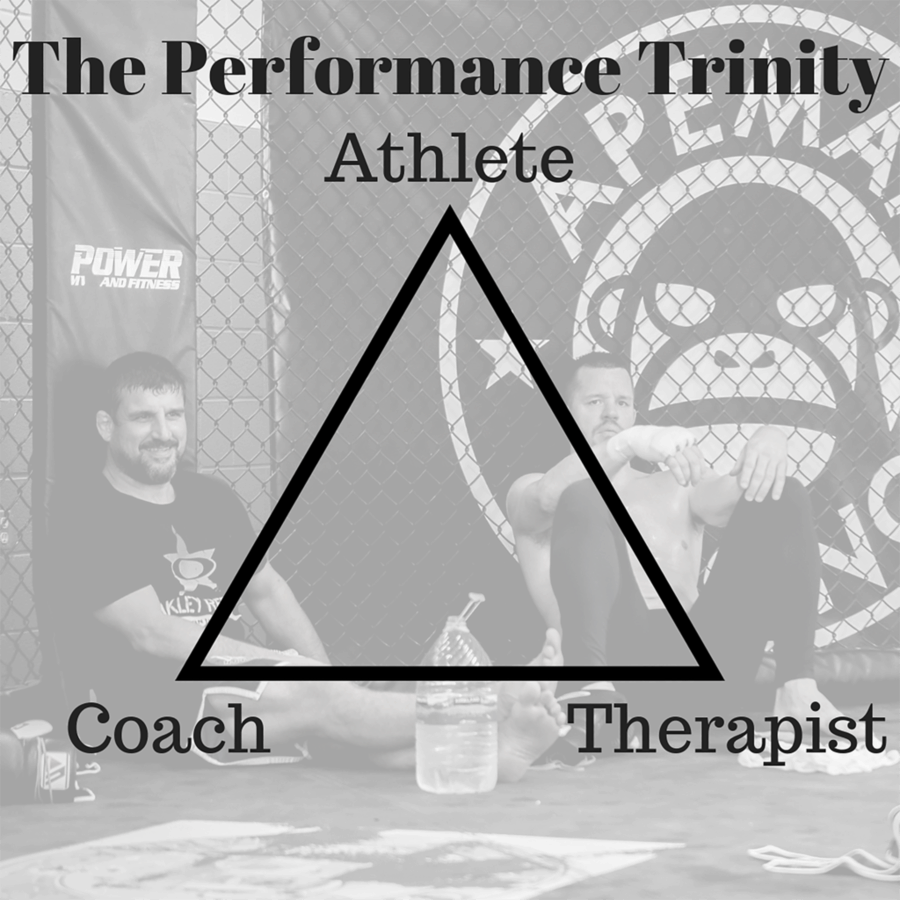
My opinion might be biased, however, I do feel like the therapist plays a crucial role on the team. It is hard to excel in sports when you are constantly getting injured. A good therapist can help catch signs of injuries before they get out of hand. What you consider just a sore muscle might be the early signs of an injury. A good therapist should be able to give you insight into what is actually going on. They can give proper direction when an injury does happen and hopefully can give strategies to prevent injuries in the future. They can also help you move better so you which may help you to perform techniques more freely and improve your overall performance.
Final Thoughts…
If you are dealing with an injury that wont let you train or compete it is important to get checked out by a proper medical provider to rule out any major issues. However, the long term solution is making sure you are using the right equipment, living a good lifestyle, applying good load management principles, and making sure you are using proper technique.
